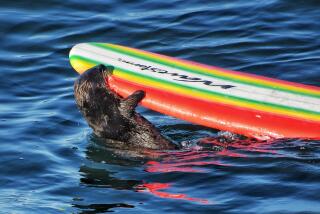Human Touch Helps Orphaned Otters Survive
- Share via
MONTEREY, Calif. — Few baby sea otters are expected to survive the Alaskan oil spill, but two pups orphaned by the disaster are being raised at Monterey Bay Aquarium by humans, who don wet suits to swim with the young mammals and give them a tasty formula of mashed fish, clams and Half and Half.
The aquarium is the only institution in the world that has raised sea otter pups successfully and the only one that has succeeded in releasing one out to the open ocean to live among its own kind.
“We . . . knew how closely the pups bond to their mothers, and when we began acting as surrogates we worried at first that we couldn’t break the bonds to us. So we tried to maintain as little human contact with the pups as possible,” said Julie Hymer, who with David C. Powell heads the team of volunteers and professionals caring for the otters.
“But now we’ve learned that gradually we can break the bond as the pups grow more independent, so we feel we’re finally on the right track at least,” she said.
The pups, called Kodiak and Annie, were rescued a few weeks ago from the oil-choked waters of Prince William Sound, where the Exxon Valdez ran aground in March. The spill killed more than 2,500 adult otters.
The two are being raised with an older pair of pups, Bear and Hoppy, who were found along the California coast.
Each day Hymer and volunteers don wet suits and swim with the pups in the large shallow tide pool outside the aquarium about 80 miles south of San Francisco.
Feeding starts with the formula, then moves to tiny bits of hand-fed seafood, and then to larger morsels served on a platter. Food is later dropped on the bottom of the tide pool so the young otters can practice picking it off the bottom.
“We can’t duplicate the incredible complexity of the underwater world out there where the otters live,” said Powell. “And hiding food items among the rocks on the bottom of a tank is not nearly the same as the real world.”
But the aquarium must provide the pups with a “real-life environment” slowly, so the animals can catch on to grown-up otter skills.
“We let them watch us foraging for food on the bottom and breaking open a shell, and eventually they learn for themselves,” Hymer said.
Scientists estimate that up to 20,000 sea otters once lived in California’s coastal waters. The population dropped below 50 by 1911 as a result of hunters. Today, the population is estimated at 1,700, including nearly 220 pups.
More to Read
Sign up for Essential California
The most important California stories and recommendations in your inbox every morning.
You may occasionally receive promotional content from the Los Angeles Times.













